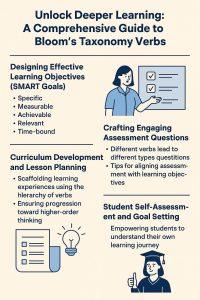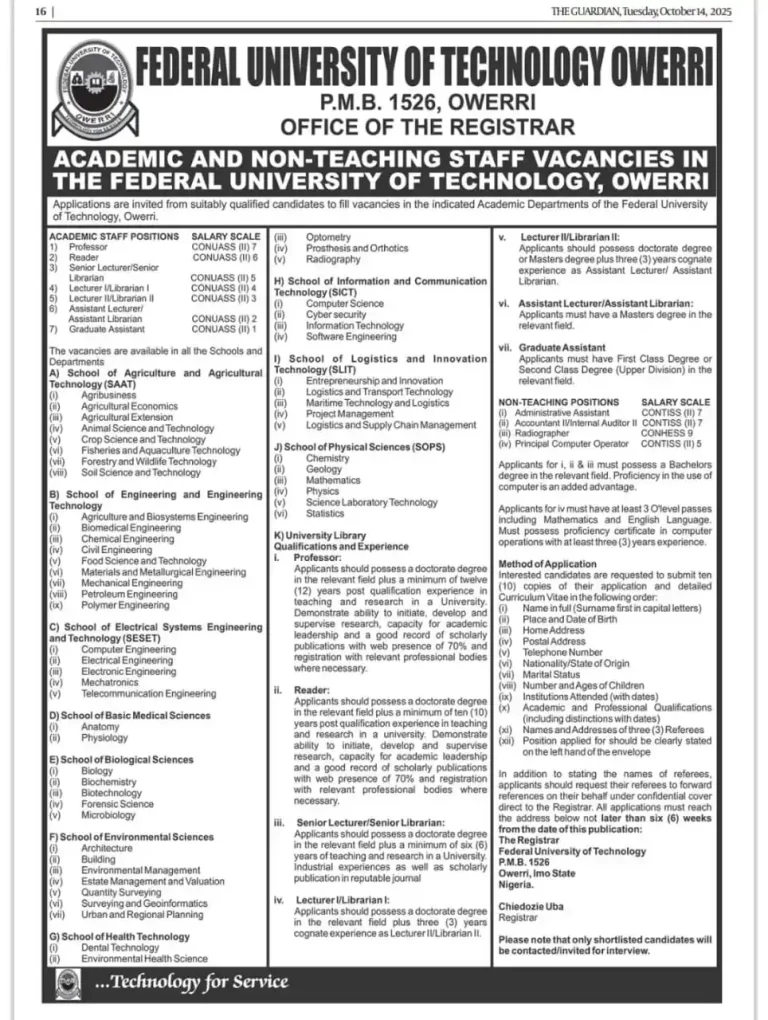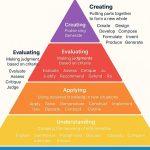
Exploring Bloom’s Six Levels of Thinking for Deeper Learning
In our previous post, we introduced Bloom’s Taxonomy as a vital framework for understanding cognitive skills and its evolution from its original form to the more dynamic, verb-focused revised framework. Now that we’ve explored the foundational ideas behind this powerful tool, let’s embark on a journey through each of the six cognitive levels. Think of this as climbing a ladder, where each rung represents a progressively more complex way of thinking and interacting with knowledge. Understanding these levels will empower you to design more effective learning experiences and recognize the depth of learning occurring.

Remembering: The Foundation of Knowledge
At the very base of Bloom’s Taxonomy lies “Remembering.” This level is all about recalling or recognizing knowledge from memory. It’s the cognitive process involved when memory is used to produce or retrieve definitions, facts, lists, or to recite previously learned information.
This foundational level is absolutely crucial because, quite simply, you can’t understand, apply, analyze, evaluate, or create something if you don’t first remember the basic facts and concepts related to it. It’s the raw material for all higher-order thinking. As research emphasizes, “No pyramid exists with only a top or a middle. There has to be a foundation, and that foundation is knowledge.” Without readily accessible facts and concepts, students cannot effectively analyze or evaluate anything. The challenge for educators is to make remembering meaningful, connecting new facts to existing knowledge structures rather than isolating them as disconnected pieces of information. This ensures that remembering is not just a passive act but an active construction of a usable knowledge base. Common activities at this stage include lectures, memorization exercises, readings, videos, and simple question-and-answer sessions. EdTech tools can greatly enhance this stage; for example, flashcard apps and spaced repetition systems can make memory retention more efficient and engaging.
Practical Examples for Everyday Recall
To illustrate, consider these examples of “Remembering” across different learning stages:
Early Learning: A preschooler recognizing primary colors by pointing to them when prompted, or a kindergartener recalling the names of the days of the week in order.
Primary/Secondary School: A third-grader listing the planets of the solar system, a fourth-grader memorizing multiplication tables, or a fifth-grader naming the 50 states and their capitals. A sixth-grader might be asked to describe the process of photosynthesis, or a seventh-grader to match historical events with their corresponding dates on a timeline.
Higher Education/Professional: A university student defining specific biological terms, or an employee recalling basic safety protocols in an LMS course on workplace safety.
Key action verbs associated with “Remembering” include: define, list, name, recall, recognize, state, describe, identify, match, and reproduce. These examples demonstrate that “remembering” is a fundamental cognitive skill across all ages and disciplines, providing the necessary building blocks for all subsequent learning.
Understanding: Grasping the “Why” and “How”
Moving up the cognitive ladder, “Understanding” is about making sense of the information you’ve remembered. It involves constructing meaning from different types of messages, whether they are written texts, graphic representations, or activities. This level goes beyond mere recall; it’s about interpreting, exemplifying, classifying, summarizing, inferring, or comparing.
“Understanding” requires more cognitive processing than simply remembering information. It’s the critical bridge where isolated facts begin to form a coherent narrative or system in the learner’s mind. This process helps learners incorporate new knowledge into their existing mental frameworks, or “cognitive schemas,” by which they understand the world. The ability to “explain course concepts in one’s own words” is a powerful indicator of true understanding, as it demonstrates internal processing and synthesis, not just regurgitation. Common activities at this level include discussions, short quizzes, “check-in” prompts, summarizing, paraphrasing, and contrasting. Interactive elements like short videos followed by comprehension questions and discussion forums can also be effectively used to foster understanding.
Real-World Scenarios for Deeper Comprehension
Here are some practical examples of “Understanding” in action:
Early Learning: A preschooler explaining the difference between hot and cold temperatures using everyday examples, or a kindergartener summarizing the main events of a short story they’ve read.
Primary/Secondary School: A first-grader classifying animals into groups based on their characteristics (e.g., mammals, birds, fish), or a second-grader comparing and contrasting the life cycles of butterflies and frogs. A student might be asked to explain the function of the left and right ventricles of the heart, or to summarize the main idea of a research article.
Higher Education/Professional: An economics student explaining the concept of supply and demand to someone new to the subject, or a professional explaining why certain safety measures are essential in different work environments.
Key action verbs for “Understanding” include: explain, summarize, interpret, paraphrase, classify, describe, discuss, give examples, associate, compare, contrast, and predict. These examples demonstrate how understanding is applied in diverse contexts, from basic scientific concepts to complex professional scenarios, signifying a true grasp of the meaning of information.
Applying: Putting Knowledge into Action
Once you remember and understand a concept, the next crucial step on the cognitive ladder is “Applying.” This level is all about using learned material or implementing it in new and concrete situations. It refers to situations where learned material is used through products like models, presentations, interviews, or simulations. Effectively, it’s where theory meets practice, and learners actively engage with the information by using it to solve problems or respond to specific situations.
“Applying” knowledge is absolutely crucial for true understanding and skill development. It moves students beyond passive learning to active problem-solving, demonstrating a grasp of the material by solving problems and creating projects. There’s a critical reciprocal relationship here: while the taxonomy suggests a linear progression, learning isn’t always a strictly one-way street. Often, we build understanding by applying knowledge and by creating things. This means that applying what you think you understand can often reveal gaps or misconceptions, prompting you to revisit and deepen your comprehension. This iterative process of applying, reflecting, and refining understanding is far more reflective of real-world learning and complex problem-solving than a rigid upward climb. Educators should therefore design learning experiences that encourage early and frequent application, even before “full” understanding is perceived to be achieved, as this active engagement can actually facilitate deeper understanding and reveal areas for further learning. Common activities at this level include demonstrations, group presentations, illustrating concepts, completing graphic organizers, problem sets, role-playing, practical scenarios, and case studies.
Demonstrating Skills in New Situations
Here are practical examples of “Applying” knowledge in various contexts:
Early Learning: A preschooler using primary colors to create secondary colors through mixing paints, or a kindergartener applying knowledge of simple addition and subtraction to solve basic word problems.
Primary/Secondary School: A first-grader demonstrating how to measure the length of an object using a ruler, or a second-grader applying the concept of symmetry to create symmetrical drawings or designs. A student might use a compass and map to find directions, solve basic algebraic equations, or apply knowledge of fractions to real-life problems involving measurements.
Higher Education/Professional: A medical student, when presented with images of ventricular hypertrophy, being able to prepare an order for the necessary tests associated with the diagnosis. An engineering student using the Pythagorean theorem to solve a practical problem in a real-world scenario, or a chemistry student demonstrating how to conduct a chemical titration in a laboratory setting. A project manager might apply project management techniques to develop a detailed plan for a hypothetical scenario.
Key action verbs for “Applying” include: apply, use, demonstrate, construct, solve, operate, implement, execute, illustrate, practice, calculate, show, employ, and dramatize. These examples showcase the diverse ways applying knowledge transforms abstract concepts into tangible skills, proving that learning has moved beyond mere recall and comprehension to active utilization.
Analyzing: Deconstructing for Clarity
As we continue our ascent, “Analyzing” represents a significant cognitive leap. This level is the ability to break down or distinguish the parts of material into its components so that its organizational structure may be better understood. It involves differentiating, organizing, and attributing, and is where critical thinking truly enters the picture. This stage requires learners to move beyond simply using information to understanding its internal mechanics and relationships, identifying patterns and trends in the course material.
This cognitive leap is essential for effective problem-solving, as it allows learners to diagnose issues by dissecting complex situations into manageable parts. It’s also where students begin to develop a “systems thinking” approach, recognizing how different elements interact within a larger whole, a crucial skill in fields like technology and engineering. Analysis requires learners to differentiate between fact and opinion, identify the claims upon which an argument is built, and break down information needs into their component parts to identify the most appropriate search terms. This level encourages students to ask questions, think critically, and even propose alternative solutions. Common activities at this level include simulations, role-playing, labs, debates, and essays. Case studies, comparison charts, and activities that require close reading and evidence gathering are also highly effective for fostering analytical skills.
Critical Thinking in Action: From Data to Insights
Here are practical examples of “Analyzing” in various contexts:
Early Learning: A preschooler sorting objects into different categories based on common attributes (e.g., size, color, or shape), or a kindergartener comparing and contrasting the similarities and differences between two story characters.
Primary/Secondary School: A first-grader analyzing a simple story to identify the problem and solution presented in the narrative, or a second-grader breaking down the steps of a plant or animal life cycle into a clear sequence. Students might examine patterns in multiplication tables, investigate the causes and consequences of environmental issues like pollution, or dissect a simple machine to identify the function of its various components.
Higher Education/Professional: Troubleshooting equipment or software by breaking down the issue into its components. Analyzing a case study to determine which safety protocols were effective and where there were lapses. Identifying the key factors contributing to the decline of a particular species in an ecosystem, or analyzing how social and economic factors influence voting patterns in a specific region. Comparing and contrasting the economic policies of two different countries and their impact on income inequality.
Key action verbs for “Analyzing” include: analyze, compare, contrast, differentiate, distinguish, examine, investigate, categorize, classify, organize, question, test, infer, deduce, and scrutinize. These examples demonstrate how analysis is fundamental to problem-solving, deep disciplinary understanding, and making sense of complex information in various fields.
Evaluating: Making Informed Judgments
Nearing the summit of the cognitive ladder, “Evaluating” involves making judgments based on criteria and standards. This process can be based on internal evidence or external criteria, and includes appraising, critiquing, defending, or supporting a position. This level is crucial for critical thinking, requiring students to reflect on teaching sessions, judge the value of information, and appraise validity.
Evaluation is not just about forming an opinion; it’s about forming justified opinions based on explicit criteria and evidence. This process cultivates intellectual rigor and discernment, moving students beyond subjective preferences to objective reasoning. In a world saturated with information, the ability to critically evaluate sources and arguments is paramount, fostering informed decision-making and resistance to misinformation. This level also implicitly encourages ethical reflection, as judgments often have significant consequences. Common activities at this level include peer reviews, self-assessments, debates (where students must defend their viewpoints with solid reasoning and evidence), critiquing concepts, assessing solutions, and justifying choices with evidence.
Developing Discerning Minds: Weighing Evidence and Criteria
Here are practical examples of “Evaluating” in various contexts:
Early Learning: A preschooler selecting the most suitable tool to complete a specific task or solve a simple problem, or a kindergartener assessing which of two solutions is more effective for a given situation in a story.
Primary/Secondary School: A student determining the best course of treatment for an initial diagnosis of left ventricular hypertrophy based on a patient’s specific medical history.
Higher Education/Professional: Critically assessing the validity of a research study, evaluating different leadership approaches and deciding which is most effective for a given situation, comparing and contrasting the strengths and weaknesses of two different programming languages for a specific project, or assessing the effectiveness of a marketing campaign and providing recommendations for improvement. This level also involves holistically appraising ethical consequences of alternative courses of action.
Key action verbs for “Evaluating” include: evaluate, assess, critique, judge, defend, argue, appraise, recommend, select, support, determine, justify, weigh, and prioritize. These examples highlight how evaluation skills are vital for navigating complex situations, making sound judgments, and fostering a discerning mind.
Creating: Innovating and Producing Original Work
At the very pinnacle of the revised Bloom’s Taxonomy sits “Creating.” This is the highest level of cognitive learning, involving generating new ideas, products, or ways of viewing things. It’s about putting elements together to form a coherent or functional whole, reorganizing elements into a new pattern or structure. This level emphasizes creativity and the production of a new or original end product, integrating existing knowledge and skills from all lower levels.
Creating represents the ultimate demonstration of mastery because it requires the synthesis and application of knowledge from all lower levels in a novel way. It’s not just about producing something new, but about the cognitive process of innovation – identifying gaps, imagining possibilities, and structuring disparate elements into a cohesive whole. This level is particularly vital for preparing students for real-world challenges, where adaptive problem-solving and original contributions are highly valued. It also fuels intrinsic motivation, as students experience the profound satisfaction of bringing new ideas to life. As research suggests, “The creation process is where we construct deep understanding.” Common activities at this level include designing processes, programs, or equipment; composing, generating, devising, writing, integrating, organizing, planning, proposing, developing, formulating, and compiling.
From Concepts to Creations: Designing and Developing
Here are practical examples of “Creating” in various contexts:
Early Learning: A preschooler creating a collage using various materials to express an idea or emotion, or a kindergartener inventing a new ending for a familiar story by drawing or writing a short narrative.
Primary/Secondary School: A student designing a new product, writing a new recipe, or developing a proposal. A student might also create their own rap using academic vocabulary covered in a lesson, complete with a rhyming dictionary and beats library.
Higher Education/Professional: Designing a process, program, or equipment to perform a specific task. Developing an adapted treatment plan with possible outcomes when presented with a failed initial treatment scenario. Designing an original science experiment, or creating a project plan for a hypothetical scenario, incorporating all learned concepts. Proposing a novel solution to reduce urban congestion while promoting eco-friendly transportation options.
Key action verbs for “Creating” include: create, design, compose, invent, develop, formulate, generate, build, construct, devise, plan, propose, assemble, author, integrate, organize, and modify. These examples beautifully illustrate how the highest level of Bloom’s Taxonomy translates into tangible innovation and real-world impact, showcasing a profound level of cognitive mastery.
Conclusion
Climbing the cognitive ladder of Bloom’s Taxonomy reveals a clear progression from foundational recall to complex creation. Each level plays a crucial role in fostering deeper learning and preparing individuals for the challenges of a dynamic world. By understanding and intentionally designing for “Remembering,” “Understanding,” “Applying,” “Analyzing,” “Evaluating,” and “Creating,” educators can empower learners to engage with information more profoundly and develop versatile critical thinking skills. In our final blog post, we will delve into the practical strategies for implementing Bloom’s Taxonomy, address common critiques, and explore its amplified relevance in the age of Artificial Intelligence. Stay tuned for actionable insights!








